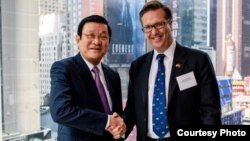Editor’s note: Commerce ministers of ASEAN will meet for a trade meeting and exchange with US businesses in San Francisco next week. The Feb. 17 exchange coincides with the meeting of ASEAN leaders with US President Barack Obama earlier in the week, in Sunnylands, in Southern California. The San Francisco meeting, sponsored by the US-ASEAN Business Council, is meant to “elevate the dialogue in the United States about the importance of ASEAN,” Alexander Feldman, president of the council, tells VOA Khmer. Feldman recently spoke to VOA Khmer about the prospects for ASEAN-US investment, and what still needs to be done to improve it.
What will be on the agenda for discussion at the conference?
It’s a whole-day conference. It focuses really on one thing, the ASEAN Economic Community, and the opportunity for business in ASEAN. So we’ll talk and hear from experts and leading businesses about doing business in ASEAN, the importance of ASEAN, from both the internal point of view and trade’s point of view, internally, as well as from an external point of view. We’ll look at things like ASEAN trade agreements with other parts of the world, including the United States. So we will talk about RCEP, the Regional Comprehensive Economic Partnership, as well as the TPP [the Trans-Pacific Partnership].
When it comes to investment, what do US companies normally look at in countries within the ASEAN community?
They are looking for competitive advantages, and they’re looking at the ease of being able to supply other markets from that particular country. So a country like Cambodia, although maybe it’s a little smaller than some countries, including countries like Indonesia, has an opportunity, because geographically it is at the center of ASEAN. So then there is a question of what is the other competitive advantage of that particular country? Cambodia has competed with the labor pool, its ability, as well as its cost competiveness.
ASEAN nations officially launched the ASEAN Economic Community at the end of 2015. What does this mean for potential investment?
I think it’s a great, great step forward. Obviously, the world did not change on Jan. 1, after it was launched on Dec. 31. But there are a number of important things that have been accomplished already, including the ASEAN Free Trade Area, pretty much the tariff is down zero for anything imported from other ASEAN countries, as long as it qualifies for the value added that has been put in Cambodia, for instance.
Going forward, we are looking at how the ASEAN countries can go beyond the border, as we say, to tackle some of the impediments of trade that includes non-tariff barriers. We look forward to more harmonization within ASEAN, especially procedure and ruling. One of the examples that we give often is the ASEAN agreement on cosmetics, which has allowed the non-tariff measures around cosmetics to be harmonized, and then harmonization of regulations is really critical to ASEAN moving forward. We want to see more of that. That’s what all companies are looking for. We certainly have to look at each country for their own geographic and competitive advantage.
We hope that ASEAN in the second blueprint, which runs through 2025, will continue to take major steps forward. The ASEAN single window is probably the thing that is most exciting in 2016. Five countries will start the trial for the first half of the year. For the other ASEAN single window, we understand that the other five countries are not far from behind. That’s very exciting, because that allows companies to file custom paperwork electronically, and there will also be a single form that everyone will use, no matter which countries in ASEAN that we’re going to enter into. So it’s a great step forward, and many ASEAN single windows can, in fact compete among all 10 countries in 2016. ASEAN will take a major step forward.
Trade between the US and ASEAN has been flourishing, but what are the structural concerns remaining for US investors?
The vision of the ASEAN Economic Community isn’t quite to where American businesses hoped it would be by this time. So we hope that ASEAN will continue to integrate, continue to reform, to harmonize regulations. We hope that ASEAN countries will continue to provide incentives for investment to attract investment from around the world and around Asia.
We still see impediments, including challenges of governance, so corruption being a challenge in ASEAN and ASEAN single window, addresses one major place where we see a lot of corruption at customs. We still see a lack of transparency on how regulations are put in place and how rules are enforced. We’d like to see those tackled in a much stronger way. We’d still love the ASEAN governments to continue to tap on all their stakeholders, including in this case, the American business community, the international business community, because we have a lot of experience and a lot of things we can bring to bear.
But the ASEAN Economic Community is exciting. It really has made a lot of progress. We’re excited about ASEAN. For the record, Americans believe in ASEAN, and we always have, and we’ve invested over $200 billion in ASEAN, making ASEAN the largest single destination of American Foreign Direct Investment anywhere in Asia, by a long shot. If you add up all the American investment in China, in South Korea, in Taiwan, in Hong Kong, and in India, they still don’t add up to as much investment as we’ve already made in ASEAN. I can tell you from my own personal experience that ASEAN was a great market, when I was in the private sector and building businesses. It’s one of the places where we really have an impact both for our own businesses, but also for the community in which we operate. That’s another side, but the American companies love to give back and our corporate social responsibility in ASEAN is also among the strongest in Asia.








